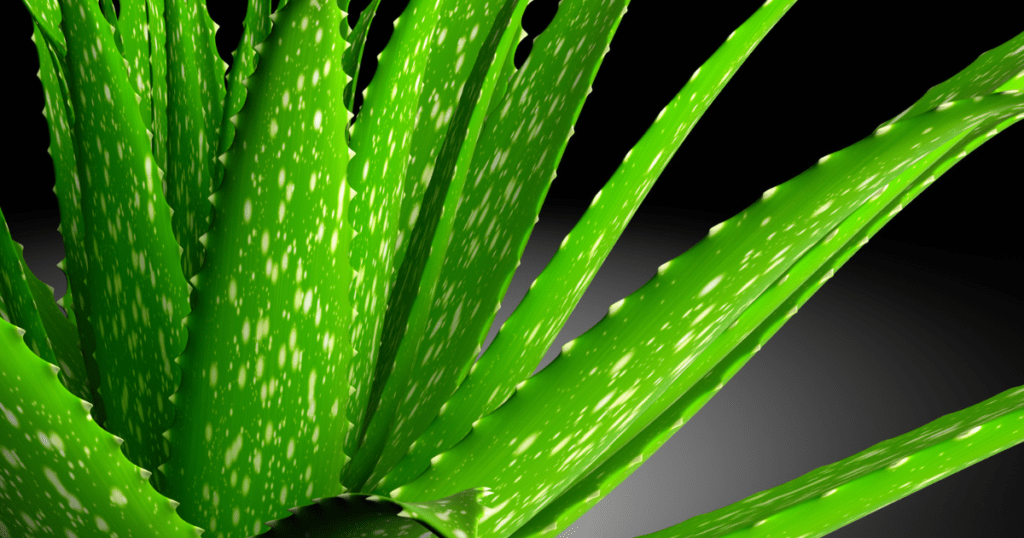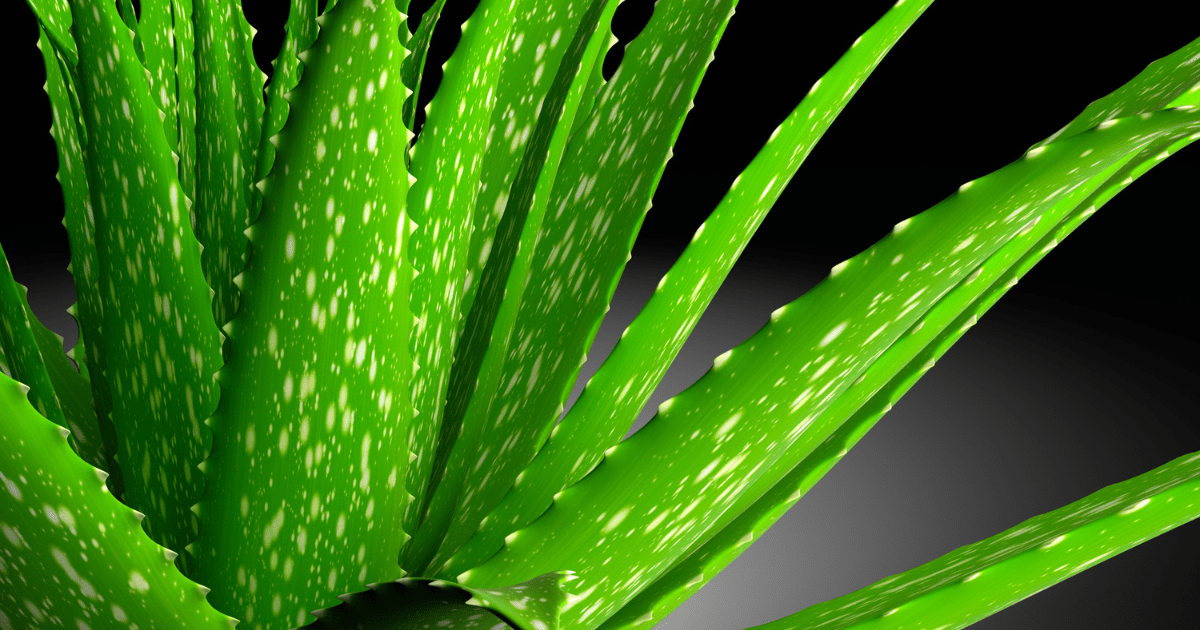Aloe Vera: Healing Power, Active Components and Mechanisms
Cultivating Aloe vera’s Healing Potential: Insights into Its Rich History, Active Components, and Clinical Applications in Modern Medicine and Skincare.
The Aloe vera plant has enjoyed a rich history spanning centuries, renowned for its diverse applications in health, beauty, medicine, and skincare. Its name, “Aloe vera,” has roots in the Arabic term “Alloeh,” signifying “shining bitter substance,” while the Latin word “vera” translates to “true.” Over 2,000 years ago, ancient Greek scholars considered Aloe vera as a universal remedy, while the Egyptians referred to it as “the plant of immortality.” In contemporary times, Aloe vera finds use in various dermatological applications.

Physical Characteristics
Most members of the Aloe genus typically form a rosette of succulent, fleshy leaves, often adorned with sharp-edged teeth. Certain Aloe species retain dead leaves around their stems, acting as insulation against wildfires. Their tubular flowers can range from white to yellow to red, and many species are pollinated by non-hovering birds like sunbirds. Dry capsules hold the seeds.
Historical Use of Aloe Vera
Aloe vera has played a medicinal role in various cultures throughout history, including Greece, Egypt, India, Mexico, Japan, and China. Legendary figures like Egyptian queens Nefertiti and Cleopatra, Alexander the Great, and Christopher Columbus have incorporated it into their beauty regimens and medical practices. The first English reference to Aloe vera dates back to John Goodyew’s translation of Dioscorides’ medical treatise in 1655. In the early 1800s, it was used as a laxative in the United States, with a significant turning point occurring in the mid-1930s when it effectively treated severe radiation dermatitis.
Plant Description
Aloe vera’s botanical name is Aloe barbadensis miller, belonging to the Asphodelaceae (Liliaceae) family. This shrubby, perennial, xerophytic plant with a pea-green hue predominantly grows in arid regions across Africa, Asia, Europe, and America. In India, it can be found in regions such as Rajasthan, Andhra Pradesh, Gujarat, Maharashtra, and Tamil Nadu.
Prominent Species and Uses
Numerous Aloe species are cultivated for their appealing architectural leaves and colorful flowers. Examples include the spiral aloe (Aloe polyphylla) known for its compact, spiny leaves forming a geometric spiral, and the Arabian aloe (A. rubroviolacea) with blue-green leaves adorned with red teeth, which thrives in warm climates. The true aloe (Aloe vera) is especially popular for its gel, used in cosmetics and as a remedy for burns and skin care.
Anatomy of Aloe Vera
Aloe vera boasts triangular, fleshy leaves with serrated edges, yellow tubular flowers, and fruit containing numerous seeds. Each leaf comprises three layers: an inner clear gel rich in water and various compounds, a middle layer containing latex with distinctive properties, and an outer protective rind. Vascular bundles within the rind aid in transporting substances like water and starch.
Active Components and Properties
Aloe vera contains approximately 75 potentially active constituents, including vitamins, enzymes, minerals, sugars, lignin, saponins, salicylic acids, and amino acids. These constituents have various beneficial properties, including antioxidants, anti-inflammatory effects, and analgesic properties.
Mechanism of Action
Aloe vera’s healing properties can be attributed to compounds such as glucomannan and gibberellin, which stimulate collagen synthesis and enhance wound healing. The gel’s influence on collagen composition and hyaluronic acid production accelerates wound contraction and increases scar tissue strength.
Aloe vera gel is known for its potential protective effects against radiation-induced skin damage. While the exact mechanism is not fully understood, the application of aloe vera gel has been shown to trigger the production of an antioxidant protein called metallothionein in the skin. This protein plays a vital role in scavenging harmful hydroxyl radicals, preventing the suppression of enzymes like superoxide dismutase and glutathione peroxidase, which are essential for skin health. Aloe vera gel also reduces the release of immunosuppressive cytokines, such as interleukin-10 (IL-10), from skin keratinocytes, thereby preventing UV-induced suppression of delayed type hypersensitivity.
Aloe vera exhibits anti-inflammatory properties by inhibiting the cyclooxygenase pathway and reducing the production of prostaglandin E2 from arachidonic acid. Additionally, recent research has isolated a novel anti-inflammatory compound called C-glucosyl chromone from aloe gel extracts.
The impact of aloe vera on the immune system is notable. Aloe components like Alprogen inhibit calcium influx into mast cells, preventing the release of histamine and leukotriene in response to antigen-antibody interactions. Studies on mice have shown that acemannan, found in aloe, stimulates the synthesis and release of immune-boosting molecules like interleukin-1 (IL-1) and tumor necrosis factor from macrophages, leading to an immune response against cancerous cells.
Aloe vera’s laxative effects can be attributed to the presence of anthraquinones in its latex, which increases intestinal water content, stimulates mucus secretion, and enhances intestinal peristalsis.
Antiviral and Antitumor Properties
The plant also demonstrates antiviral and antitumor activities, both indirectly through immune stimulation and directly through compounds like aloin, which can inactivate various enveloped viruses. Polysaccharide fractions in aloe have shown promise in preventing cancer-initiating benzopyrene-DNA adducts and inhibiting tumor-promoting effects.
Aloe vera contributes to skin health by moisturizing and potentially reducing the signs of aging. Its mucopolysaccharides help retain moisture, while it stimulates fibroblasts to produce collagen and elastin, resulting in more elastic and less wrinkled skin. Additionally, aloe has cohesive effects on superficial epidermal cells, softening the skin, and contains amino acids that help soften hardened skin cells. It also acts as an astringent due to its zinc content, tightening pores and even exhibiting anti-acne effects.
Aloe vera contains natural antiseptic agents, including lupeol, salicylic acid, urea nitrogen, cinnamonic acid, phenols, and sulfur, which inhibit the growth of fungi, bacteria, and viruses.
While it has a wide range of potential clinical uses, most of the evidence is anecdotal. Controlled trials are needed to determine its effectiveness in various diseases and conditions.
Side Effects of Aloe Vera
Aloe vera can have some side effects when applied topically, including redness, burning, stinging, and rare cases of generalized dermatitis, mainly in sensitive individuals. Allergic reactions are often related to anthraquinones like aloin and barbaloin. It is advisable to perform a patch test before widespread use.
Oral consumption of aloe may lead to abdominal cramps, diarrhea, red urine, and in some cases, hepatitis, dependency, or worsening of constipation. Prolonged use has been associated with an increased risk of colorectal cancer. The laxative effect can also disrupt electrolyte balance, particularly potassium levels.
It’s important to note that aloe vera should be avoided by individuals with known allergies to plants in the Liliaceae family. Pregnant women are advised against oral consumption due to potential uterine contractions, while breastfeeding mothers may sometimes experience gastrointestinal distress in their nursing infants.
Interaction with medications
Aloe vera may interact with other medications, such as increasing the absorption of steroid creams and reducing the effectiveness of drugs like digoxin and digitoxin due to its potassium-lowering effect. Combining aloe vera with furosemide may increase the risk of potassium depletion. It can also lower blood sugar levels, potentially interacting with oral hypoglycemic drugs and insulin.
In conclusion, while Aloe vera possesses a broad spectrum of properties and potential uses, further controlled studies are necessary to confirm its effectiveness in various conditions.
Sources:
Surjushe, A. / vasabum, R. as well as Saple, G. D. (2008). A plant called Aloe Vera. A Brief Overview. The Indian Journal of Dermatology, volume 53, issue 4, pages 163-166. //www.ncbi.nlm.nih.gov/pubmed/) Rephrased: The National Library of Medicine, Devmatol, can be accessed at the following web address: https://www.ncbi.nlm.nih.gov/pubmed/. //www.ncbi.nlm.nih.gov/pmc/articles/PMC2763764/) Accessed Nov 2, 2023
Petruzzello, M. (2023) can be paraphrased as “The author of the article is Petruzzello, M. in the year 2023.” Aloe. Britannica. (https: http: / / www.britannica.com / plant / Liliales. Retrieved on November 2, 2023
According to DermNet (2021), The skin and aloe vera. (https: Aloe vera and the skin (https: / / dermnetnz.org / topics / aloe-vera-and-the-skin) Retrieved on November 4th, 2023
Category
- Health Issues (65)
- Healthy Diet (45)
- Herbs for Health (11)
- Mental Health (31)
- Skin Care (20)

